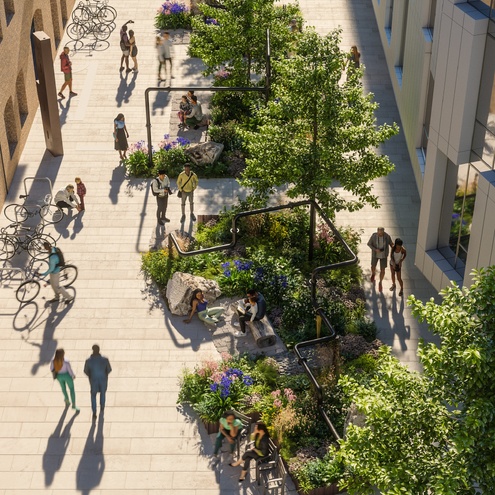Project showcase
Roots in the Sky Garden at Price’s Street, Southwark – Fabrix with Harris Bugg Studio and Mcmullan Studio

The relocation of a Gold Medal-winning Chelsea Flower Show garden to Price’s street will create a ‘pocket park’ on Southwark’s paved and pedestrianised Price Street. Flanked by hotels and apartments, Roots in the Sky Garden aims to revitalise a ‘grey’ corner of the city with 55m² new planting introduced to the 700m² area.
Who is on the project team?
Fabrix with Harris Bugg Studio, Bankside Open Spaces Trust and Kirkaldy Testing Works
Harris Bugg Studio (Landscape design) / Gerald Eve (Planning Consultant) / Mark Whyman Landscapes (Contractor) / Mcmullan Studio (Sculpture Designer) / Mike Smith Studio (Sculpture Fabricator) / Crocus (Plants & Trees Supplier)
Describe the context of this project?
The Roots in the Sky Garden at Price’s Street will see the relocation of a Gold Medal-winning Chelsea Flower Show garden, designed with reclaimed materials, to permanently transform a street in LB Southwark into a tranquil, green oasis.
Originally designed for the 2021 RHS Chelsea Flower Show, the garden stands for the importance of beautiful and restorative green space where we need them most - our towns and cities. It is inspired by the belief there is no place too small, or too urban, that cannot be transformed into a powerful, connective and transformative green space for people and wildlife.
Impact-led developer Fabrix purchased the garden with the intention to find it a new permanent home in the north of the borough – an area in need of green space – and deliver on the design’s original intent.
Working in partnership with Harris Bugg Studio and local charity Bankside Open Spaces Trust (BOST), and in consultation with Southwark’s regeneration team, Prices’ Street has been identified as the ideal location.
This narrow pedestrianised street, running parallel to and south of Southwark Street, is surrounded by a typical Bankside mix of mixed-tenure housing, cultural, commercial and hotel uses, just south of Tate Modern.
Over 93% of surrounding housing is flats, with little, if any, private outdoor space; parks and other outdoor spaces are therefore vital for residents to escape cramped living, air pollution and urban life, for respite and relaxation. And yet, there’s very limited public access to green space nearby.
How are you seeking to foster community?
The project will see the creation of new green space in a densely-populated area, providing powerful benefits for people and wildlife, as well as for the climate and environment.
Working in consultation with local partners and neighbours, the garden has been redesigned for its new permanent location, incorporating existing trees on the site and taking into account extension plans for the two bordering hotels, the local Kirkaldy Testing Works museum and feedback from the community.
The garden will be located just around the corner from Fabrix’s award-winning redevelopment of Blackfriars Crown Court – Roots in the Sky, which will combine next-gen workspace with London’s first rooftop forest, also designed by Harris Bugg Studio.
This ‘grey to green’ pocket park at Price’s Street will provide respite from the hectic, urban world, and breathe new life and purpose into an otherwise ‘grey’ corner of the city with very little public access to green space for the majority of the local community.
Gardens at nearby Hopton’s Almshouse and Neo Bankside are both private, the community garden at the far side of Tate Modern is password-controlled, and Redcross Way and Mint Street are too far away to be easily accessed. Tate Modern’s lawns are the nearest green space but are at capacity, with constant use by tourists and visitors, and offer minimal variety in planting and biodiversity.
The aim is to inspire others to see how the most unlikely places can be transformed into welcoming & sustainable green spaces in towns & cities everywhere.
What is your sustainability strategy and how are you mitigating carbon use and construction pollution?
The garden is designed with sustainability at its core and a commitment to its permanent relocation as a ‘pocket park’, offering new green space and breathing life into an otherwise ‘grey’ corner of the city.
By increasing the number of trees and plants in the locality the project contributes to urban cooling, improved air quality and resilience to climate change – urban greening is proven to reduce local temperatures and air pollution. 155m² new planting will be introduced into a 700m² area that is fully paved, providing a porous surface for rainwater to filter through and storing carbon.
The design incorporates all the plants and features of the original garden – including sea buckthorn, black gum trees and autumn olive – living and breathing a ‘reuse’ ethos. Planting is specified for its tolerance to tough urban environments and climate extremes, ensuring the robustness required for its setting and increasing demands of climate change.
Hard materials are recycled and reclaimed, wherever possible, showing how repurposed items can be beautiful and environmentally responsible – notably, a 100m-long metal sculpture winding its way through the planting, forged from reclaimed industrial pipework. Natural timber & stone are prioritised for seating.
The project will demonstrate the contribution of new green infrastructure, however small, to the regeneration and environmental resilience of urban areas. In an area of open space deficiency, high building density and land values, the best chance to create accessible, green, public, open space is to green the existing urban realm, pavements and streets.
Describe the social impact of the project: How is this place contributing to the economic, environmental and social wellbeing of its citizens?
This is a garden that strives to communicate the value of good placemaking & champion the breathing of new life into places that need them most.
It will provide the local community with free and open access to nature & the benefits this can bring in terms of improved health and wellbeing and social cohesion. High-quality design will ensure it makes a valuable contribution to improved placemaking, and the knock-on economic benefits this can bring to an area.
The garden will create valuable new and improved amenity space for Kirkaldy Testing Works – a one-of-a-kind but currently little-known museum fronting onto Price’s Street, home to the world’s first machinery to scientifically test structural building materials, dating from the 1860s.
The original Chelsea garden has been redesigned to complement the Testing Work’s own plans for a new entrance to the museum, significantly improving its accessibility, and incorporates two listed ‘extension beams’, bringing the museum out into the public realm for all to enjoy.
BOST – the local not-for-profit working to protect, preserve and enhance green space around SE1 – will lead an ongoing programme to engage residents on local housing estates, hosting gardening clubs and regular children’s workshops.
The care and maintenance of the garden will also be embedded in the local community. BOST will use the garden to train up future gardeners via its “Landscape Academy”, upskilling local people. Graduates will be able to apply for a permanent role to care for the garden and manage its ongoing maintenance.
Festival of Pineapples
24-26 February 2026
Pineapples prize giving night
April
Pineapples at Festival of Place
10 June 2026
© The Pineapples - Tweak Ltd. 124 City Road, London, EC1V 2NX. Tel: 020 3326 7238




